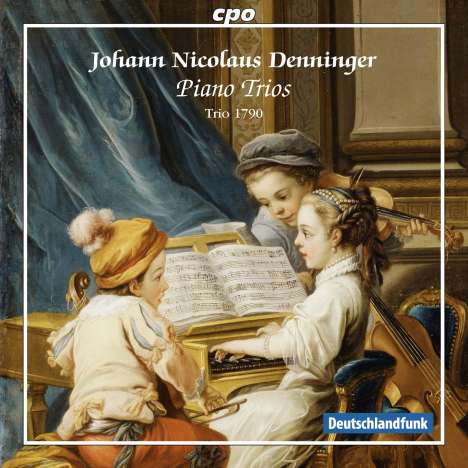Johann Nicolaus Denninger: Klaviertrios op.4 Nr.1-3 auf CD
Klaviertrios op.4 Nr.1-3
Herkömmliche CD, die mit allen CD-Playern und Computerlaufwerken, aber auch mit den meisten SACD- oder Multiplayern abspielbar ist.
Lassen Sie sich über unseren eCourier benachrichtigen, falls das Produkt bestellt werden kann.
+Klaviertrio G-Dur
- Künstler:
- Trio 1790
- Label:
- CPO
- Aufnahmejahr ca.:
- 2013
- UPC/EAN:
- 0761203792627
- Erscheinungstermin:
- 20.7.2015
Ähnliche Artikel
Brillante Klaviertrios – Neu entdeckt
Johann Nicolaus Denninger ist einer der zahlreichen Musiker der zweiten Hälfte des 18. Jahrhunderts, die in der Mehrfachfunktion als Instrumentalist, Komponist und verantwortlicher Musikdirektor nicht unwesentlich dazu beigetragen haben, für die „Großen“ ihrer Epoche das Feld zu bestellen. In Öhringen, der Residenz des Fürsten Ludwig Friedrich Carl von Hohenlohe-Neuenstein wirkte Denninger von 1780 bis 1800 als Musikdirektor in der Hofkapelle und war auch für die Kirchenmusik zuständig. Für beide Bereiche hatte er zu komponieren. Erhalten sind leider nur einige wenige Instrumentalwerke, in deren Mittelpunkt sein Hauptinstrument, das Cembalo respektive der in Mode gekommene Hammerflügel steht. Formal wie stilistisch repräsentieren diese Werke den Entwicklungsstand der beiden letzten Jahrzehnte des ausgehenden 18. Jahrhunderts, für die Haydn und Mozart die entscheidenden Maßstäbe gesetzt haben. Die Allegro-Kopfsätze seiner Werke stehen – bis auf eine Ausnahme – im Vierertakt und sind der Sonatenform verpflichtet; die heiteren Schlusssätze in volkstümlicher Charakteristik zeigen Rondoformen in ihren diversen Spielarten und sind vorwiegend im fröhlichen, an Jagdsignalen orientiertem 6 / 8-Takt gehalten, während als Mittelsatz sowohl das höfische Menuett mit Trio als auch das liedhafte, für brillante Variationen geradezu prädestinierte Andante erscheint.
Product Information
Brilliant Piano Trios – Recently Discovered
Johann Nicolaus Denninger numbers among the many musicians from the second half of the eighteenth century who in their multiple roles as instrumentalists, composers, and responsible music directors contributed not inconsiderably to tilling the field for the greats of their epoch. Denninger worked in Öhringen, the residence of Prince Ludwig Friedrich Carl von Hohenlohe-Neuenstein, as the music director of the court ensemble from 1780 to 1800 and was also in charge of church music. He had to produce compositions for both areas. Unfortunately, only a few of his instrumental works are extant, and in them his main instrument, the harpsichord or the fortepiano then coming into fashion, occupies the focus. Formally and stylistically, these works represent the state of development during the last two decades of the eighteenth century, a period for which Haydn and Mozart set the decisive standards. The allegro first movements of Denninger’s works – with one exception – are in 4 / 4 time and obliged to the sonata form; the mirthful concluding movements of folk character exhibit rondo forms in their diverse playing styles and are primarily maintained in a 6 / 8 time modeled on hunting signals; and both the courtly minuet with a trio and the andante of song character absolutely predestined for brilliant variations occur as the middle movements.
Disk 1 von 1 (CD)
Trio für Klavier, Violine und Violoncello G-Dur
-
1 1. Allegro molto
-
2 2. Menuetto
-
3 3. Rondo: Allegro
Trio für Klavier, Violine und Violoncello Es-Dur op. 4 Nr. 1
-
4 1. Allegro assai
-
5 2. Rondo: Allegro
Trio für Klavier, Violine und Violoncello A-Dur op. 4 Nr. 2
-
6 1. Allegro
-
7 2. Cantabile
-
8 3. Rondo: Allegro
Trio für Klavier, Violine und Violoncello B-Dur op. 4 Nr. 3
-
9 1. Allegro assai
-
10 2. Andante con variazioni
Mehr von Trio 1790
-
Leopold KozeluchKlaviertrios P.IX:Nr.9,17,43CDVorheriger Preis EUR 14,99, reduziert um 0%Aktueller Preis: EUR 2,99
-
Joseph HaydnSämtliche Klaviertrios9 CDsAktueller Preis: EUR 29,99
-
Ignaz PleyelKlaviertrios C-Dur,e-moll,A-Dur,f-moll (Ben 441,435,448,442)CDVorheriger Preis EUR 14,99, reduziert um 0%Aktueller Preis: EUR 7,99
-
Carl Philipp Emanuel Bach6 KlaviertriosCDAktueller Preis: EUR 7,99
















